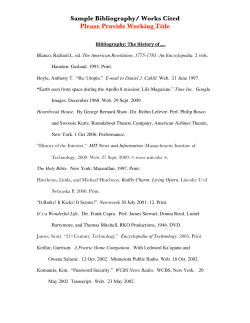
Eddy Currents and Induction Braking By: John Norris
Eddy Currents and Induction Braking By: John Norris Date: Oct. 22, 2012 What is Induction? Faraday’s Law: “The induced electromotive force in any closed circuit is equal to the negative of the time rate of change of the magnetic flux through the circuit.” Lenz’s Law Why circuits obey Newton’s third law along with the conservation of energy “An induced electromotive force (emf) always gives rise to a current whose magnetic field opposes the original change in magnetic flux” Induction Currents = Eddy Currents Called “Eddy” since they are analogous to fluid eddies in formation and behavior Responsible for the opposing magnetic fields that produce drag and heating effects The drag effects give rise to induction braking Absent external potentials will result in the system coming to a halt Heating effects are exploited by devices such as induction cookers If left unchecked, then it could result in serious damage to mechanical/circuit components Check on Heat Effects High voltage circuits are constructed as a series of “laminations” to reduce eddy currents Solid conductors would suffer increased resistivity and large energy losses (heat) Drag Effects: Magnetic Braking Not to be confused with stellar magnetic braking The primary reason for slow stellar rotations Utilized in many practical applications: Trains (Maglev and conventional) as a braking system Some roller coasters Braking Industrial equipment and power tools Some exercise equipment Rowing or Spin machines… to increase resistance Determining structural defects in conductive materials Metal Detectors Circular vs. Metal disc, on the end of a rotor assembly, placed between two electromagnets Linear Static bank of magnets/conductors located on the tracks with conductors/magnets on the car Advantages Quiet Almost no wear Wear only if coolant system failure Essentially zero maintenance Produce no chemical pollution Dust Smell Physical waste No toxic chemicals Disadvantages Need conventional brakes to hold a vehicle stationary In reality certain sections of railroad tracks have lots of brake activity Excess heat would cause structural issues Reduce brake effectiveness Increased cost Regenerative Braking Still not widely used Basic idea has been around since the industrial revolution Flywheels (mechanical capacitor) Flywheels still used, but eddy currents can be exploited for this end as well Capture the energy from the induced currents instead of it just being allowed to dissipate as heat Avoids problem of having to carry around big flywheels Demonstration Copper pipe & Neodymium magnets Pipe Dimensions: ½” and ¾” diameter (outer) pipes both ≈ 1/32” thick Magnets: (NdFeB) ½” diameter N42 Axially magnetized Pull Force: 3.1 lbs Surface Field: 1601 Gauss (0.1601 T) Magnets have been weakened due to an living an abused life For increase braking effect: More powerful magnet Thicker contiguous pipe Use more strongly conductive diamagnetic material Lower temperature (pipe not magnet) Great Videos: Liquid N2 and copper tube magnetic levitation http://www.youtube.com/watch?v=AzOSYJmY LTg&feature=watch_response Induction heater levitation molten aluminum http://www.youtube.com/watch?v=Q6Zrnv4Otb U&feature=related Worlds Strongest Magnet Shot in the MagLab http://www.youtube.com/watch?v=QGytW_C6 hR8&feature=watch-vrec References 1. 2. 3. 4. 5. 6. 7. 8. "Diamagnetism." Wikipedia. Wikimedia Foundation, 16 Oct. 2012. Web. 19 Oct. 2012. <http://en.wikipedia.org/wiki/Diamagnetism>. "Eddy Current Brake." Wikipedia. Wikimedia Foundation, 10 Nov. 2012. Web. 19 Oct. 2012. <http://en.wikipedia.org/wiki/Eddy_current_brake>. "Eddy Current Brakes." How Do Eddy-current Brakes Work? A Simple Introduction. N.p., n.d. Web. 19 Oct. 2012. <http://www.explainthatstuff.com/eddy-current-brakes.html>. "Eddy Current." Wikipedia. Wikimedia Foundation, 16 Oct. 2012. Web.19 Oct. 2012. <http://en.wikipedia.org/wiki/Eddy_current>. "Faraday's Law of Induction." Wikipedia. Wikimedia Foundation, 17 Oct. 2012. Web. 19 Oct. 2012. <http://en.wikipedia.org/wiki/Faraday's_law_of_induction>. "Lenz's Law." Wikipedia. Wikimedia Foundation, 16 Oct. 2012. Web. 19 Oct. 2012. <http://en.wikipedia.org/wiki/Lenz's_law>. “Neodymium Disk Magnets" K&J Magnetics. N.p., n.d. Web. 19 Oct. 2012. <https://www.kjmagnetics.com/proddetail.asp?prod=D81>. "Regenerative Brakes." How Do Regenerative Brakes Work? N.p., n.d. Web. 19 Oct. 2012. <http://www.explainthatstuff.com/howregenerative-brakes-work.html>. Diamagnetism (wiKi) Believed to be caused by the alteration of the electron orbital velocities Caused by quantum mech (Landau Levels) Copper – Diamagnetic Diamagnetism primarily responsible for the Lenz Law interaction Superconductors completely repel external magnetic fields Alters magnetic dipole moment Field will oppose the the magnetic field changes due to the external field All conductors exhibit an effective diamagnetism when they experience a changing magnetic field. The Lorentz force on electrons causes them to circulate around forming eddy currents. The eddy currents then produce an induced magnetic field which opposes the applied field, resisting the conductor's motion. Joke: Of course if I could have had some gold piping the effect could have been much stronger but I probably wouldn’t have brought it to class Magnetic permeability < or = 1 All conductors exhibit an effective diamagnetism when they experience a changing magnetic field. The Lorentz force on electrons causes them to circulate around forming eddy currents. The eddy currents then produce an induced magnetic field which opposes the applied field, resisting the conductor's motion. Super Conductors Pic: Neodynium iron boron mags What does 42 MGOe mean? Mega Gauss Oersted – magnetic energy product
© Copyright 2025












